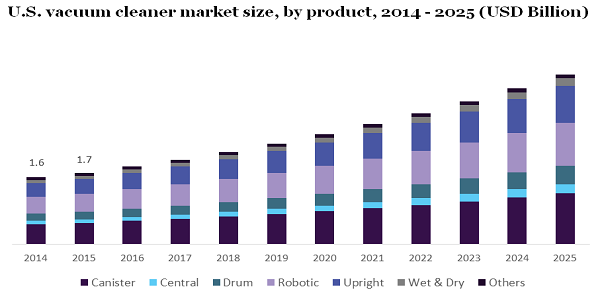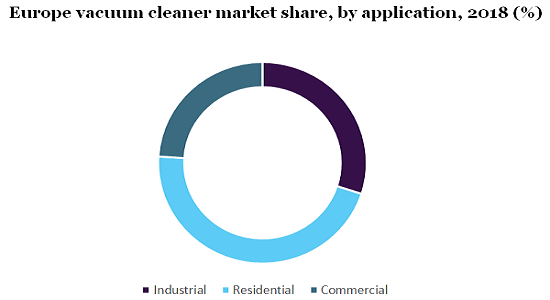- US: +1-408-610-2300
- Toll Free: +1-866-831-4085
- Become a Client
The global vacuum cleaner market size was valued at USD 9.2 billion in 2018 and is expected to grow with a CAGR of 9.1% over the forecast period, from 2019 to 2025. The market is projected to witness remarkable growth due to the rapidly changing consumer standard of living and the increasing number of working women in developing nations. The rising awareness about the advantages of vacuum cleaners such as times-efficiency, convenience, and other benefits is anticipated to surge the market growth over the forecast period. Further, the introduction of vacuum cleaners with advanced features that are highly efficient to grab small particles of dust and dirt is expected to drive the demand for this product in the next few years.
The inception of smart devices and growth in the corporate sector is projected to increase the demand for vacuum cleaners in the forthcoming years. In addition, the growing demand for energy-efficient and eco-friendly vacuum cleaners is creating new avenues for market growth. Moreover, the increasing adoption of this product in several industries including retail, manufacturing, and healthcare to maintain cleanliness and hygiene at the workplace is projected to boost the vacuum cleaner demand over the forecast period.

The rising demand for handheld, battery-powered, and small-sized vacuum cleaners is projected to drive market growth in the next six years. Vacuum cleaners have major applications across several industries and homes. The emergence of energy-efficient coupled with increasing demand for eco-friendly consumer electronic devices are anticipated to boost the market growth.
The presence of online channels, retail avenues, and marketing campaigns has led to increasing awareness of hygiene coupled with rising demand for a variety of different cleaning models that are expected to propel the demand for this market. Additionally, energy-efficient cleaning equipment along with automated mode is highly used in residential areas.
On the other hand, the availability of counterfeit products under the same brand name, poor quality in post-sale service, and less availability of spare parts are projected to hamper the market growth. Although manufacturers focus on manufacturing products that are economical, the final price of products is high; this is expected to restraint market growth. However, the market is expected to witness significant growth in the service and hospitality industry in the next few years.
Based on products, the vacuum cleaners market is divided into the canister, central, drum, robotic, upright, wet & dry, and others. In 2018, canisters held the largest market share in terms of revenue. Canisters are household devices that are specially designed for removing dirt and allergy from the floor. These vacuum cleaners are highly effective and flexible in the corners of cleaning areas. Upright models are expected to gain significant market share due to the technological difference in the overall context. These models are mostly preferred by consumers due to their convenience features including lightweight, portability, and small size. The advent of bagless and cordless upright vacuum cleaners is projected to drive segment growth due to its several benefits like fast cleaning, noise-free, lightweight, and high flexibility.
The robotic vacuum cleaners are gaining traction, as they are enabled with advanced features like voice control, remote control, and navigation technology. These features save users time, as they do not need supervision, thereby expected to drive the robotic market growth. In addition, these vacuum cleaners can be controlled from any place through a mobile app. Thus, several advanced features are expected to influence consumers for adopting robotic vacuum cleaners.
In 2018, the online distribution channel dominated the market due to the rising popularity of e-commerce portals and social media. Consumer feedback on social media plays a vital role in purchasing decisions of cleaning appliances among consumers. In addition, factors like post-sale services and technical support through chats and voice calls are expected to contribute a positive impact on market growth. The increasing number of smartphone users is expected to reshape market growth in the next six years.
Manufacturers are implementing innovative practices in the e-commerce space like ‘concept testing’. This initiative will help to gain a maximum customer base, which depends on reviews analysis. For example, Dyson focuses on introducing cordless vacuums cleaner both for small and large-sized homes. The cordless vacuum cleaners are highly energy-efficient, give high performance and high-end convenience. Additionally, Dyson offers vacuum cleaners with several robust features at affordable prices.
By end-use, the vacuum cleaners market is fragmented into industrial and commercial. The industrial category is further subdivided into food and beverage, construction, pharmaceutical, manufacturing, and others. The commercial segment is also sub-segmented into hospitals, retail stores, shopping malls, hospitality, and others. Restaurants, bars, and hotels are continuously under public scrutiny and judged by their standard of maintaining hygiene and cleanliness. This factor is expected to witness significant demand for vacuum cleaners in the hospitality sector.
The rising focus on developing noise-free and energy-efficient vacuum cleaners by manufacturers coupled with increasing demand for noise-free vacuum cleaners in hospitals is projected to surge the market growth during the forecast period. Additionally, the increasing awareness for keeping hospitals clean to avoid infection and cross-contamination in order to maintain a healthy environment in hospitals for patients, staff, and visitors is expected to fuel the product demand in the hospitals.
In 2018, the residential segment accounted for the largest revenue of USD 4.2 billion. This high revenue is attributed to the growing number of asthma and allergy incidence due to dirt and dust present inside the house and the increasing need to keep homes disease-free. Moreover, manufactures are engaged in developing smart residential vacuum cleaners equipped with advanced properties such as integration with security features, AI-enabled workflow, and customization. This factor is projected to increase demand for residential vacuum cleaners during the forecast period, from 2019 to 2025.

In the industrial domain, the market is very niche due to having specific features and the presence of cleaning facilities. In large production units, industrial hygiene is one of the major professional practices. Thereby industrial vacuum cleaner is projected to witness significant growth over the forecast period. In addition, vacuum sweepers play an important role in production and assembly units to maintain better hygiene conditions as well as hassle-free workflow. The rising development in the industrial sector and increasing need for safety requirements across various industries for protection against harmful dirt and dust are projected to drive market growth in the near future.
The Asia Pacific is expected to hold a dominant position in the market during the forecast period. Countries such as China and India are gaining traction due to technological advancement and rising awareness about hygiene. For example, in Indian markets, rapidly increasing urbanization has led to a hectic and busy lifestyle coupled with rising spending on home appliances is triggering the demand for vacuum cleaners among consumers.
North America is estimated to hold the second-largest share in terms of revenue, this high share can be attributed to rising consumer preference for easy-to-handle products. In consumer appliances, household appliances including vacuum cleaners are the largest market in the U.S. companies operating in consumer appliances are engaged in manufacturing eco-friendly practices to meet the environmental regulations. The growing focus of manufacturers in introducing intelligent and advanced cleaning appliances coupled with increasing demand for such products among consumers is projected to propel the regional market growth over the forecast period.
Citizens and communities across several countries are engaged in reducing the spread of coronavirus, thereby there are a host of challenges to keep the world safe and hygienic. In this pandemic situation, essential businesses and institutions have to remain in operations. Hence, cleaning professionals are engaged in sanitizing hospitals, disinfecting warehouses and cleaning store aisles where vacuum cleaner plays an important role to maintain hygiene. In addition, growing awareness regarding cleanness and maintaining hygiene among people during this situation is expected to drive market growth. Therefore, several market players are striving to come up with technologically advanced vacuum cleaner which is projected to propel the product demand in the COVID-19 outbreak.
The major players operating in this market are Samsung Electronics Co., Ltd.; Miele & Cie. KG; Miele & Cie. KG; Koninklijke Philips N.V., iRobot Corporation; LG Electronics; and Haier Group Corp.
The marketing strategies such as mutual agreements, business collaborations, partnerships, and new product development are implemented by the market players to expand business in the untapped potential market and gain a maximum customer base. For example, in 2017, iRobot Corporation introduced Roomba 890 and Roomba 690 Wi-Fi-connected vacuum robots. These robots are operated through iRobot Home App and compatible with Amazon Echo devices and Amazon Alexa including Amazon Tap, Amazon Echo, and Echo Dot.
The key players are extensively investing in R&D activities to develop and offer lightweight, portable, and intelligent vacuum cleaners. For example, in 2018, iRobot Corporation capitalized around USD 140.6 million in R&D to develop technologically advanced robotic vacuum cleaners. The partnerships with industry vendors are expected to help key players to sustain a competitive edge.
|
Attribute |
Details |
|
The market size value in 2020 |
USD 10.74 billion |
|
The revenue forecast in 2025 |
USD 16.66 billion |
|
Growth Rate |
CAGR of 9.1% from 2019 to 2025 |
|
The base year for estimation |
2018 |
|
Historical data |
2014 - 2017 |
|
Forecast period |
2019 - 2025 |
|
Quantitative units |
Revenue in USD billion and CAGR from 2019 to 2025 |
|
Report coverage |
Revenue forecast, company ranking, competitive landscape, growth factors, and trends |
|
Segments covered |
Raw product, distribution channel, application, end-use, and region. |
|
Regional scope |
North America; Europe; Asia Pacific; Latin America; and MEA |
|
Country scope |
U.S.; Canada; U.K.; Germany; France; India; Japan; China; Brazil |
|
Key companies profiled |
LG Electronics; Haier Group Corp; Miele & Cie. KG; Samsung Electronics Co., Ltd.; Bissell Inc.; Panasonic Corporation; iRobot Corporation; Koninklijke Philips N.V. |
|
Customization scope |
Free report customization (equivalent up to 8 analysts’ working days) with purchase. Addition or alteration to country; regional & segment scope. |
|
Pricing and purchase options |
Avail of customized purchase options to meet your exact research needs. |
This report forecasts revenue growth at global, regional, and country levels and provides an analysis of the latest industry trends in each of the sub-segments from 2014 to 2025. For the purpose of this study, Million Insights has segmented the global vacuum cleaner market report based on product, distribution channel, application, end-use, and region:
• Product Outlook (Revenue, USD billion, 2014 - 2025)
• Canister
• Central
• Drum
• Robotic
• Upright
• Wet & Dry
• Others
•Distribution Channel Outlook (Revenue, USD Billion, 2014 - 2025)
• Online
• Offline
• Application Outlook (Revenue, USD Billion, 2014 - 2025)
• Industrial
• Residential
• Commercial
• End-use Outlook (Revenue, USD Billion, 2014 - 2025)
• Industrial
• Manufacturing
• Food & Beverages
• Pharmaceuticals
• Construction
• Others
• Commercial
• Hospital
• Retail Stores
• Hospitality
• Shopping Malls
• Others
• Region Outlook (Revenue, USD Billion, 2014 - 2025)
• North America
• The U.S.
• Canada
• Europe
• U.K.
• Germany
• Asia Pacific
• China
• Japan
• India
• Latin America
• Brazil
• Middle East & Africa


Research Support Specialist, USA